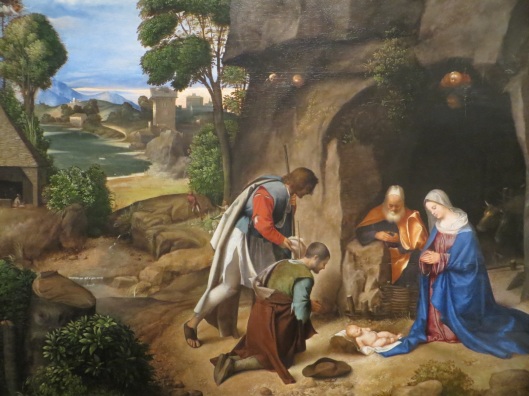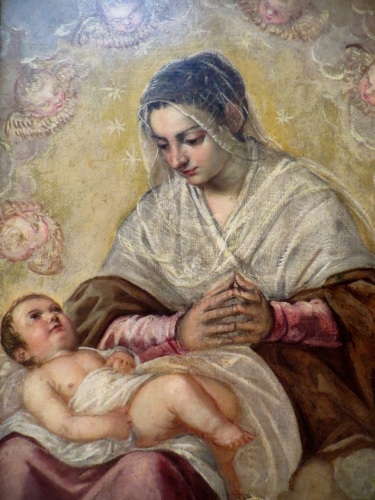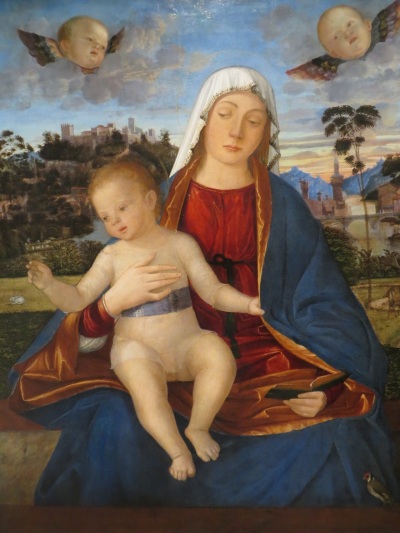Tags
Aachen, coronavirus, Germany, Italy, martyr, Palermo, pandemic, plague, Saint Corona, Saint Edmund, Saint Roch, Saint Rosalia, Saint Victor, shrine

Anthony van Dyck, Saint Rosalie Interceding for the Plague-stricken of Palermo, oil on canvas (1624). Metropolitan Museum of Art, New York. Photo via the Metropolitan Museum of Art.
The Great Plague, or Black Death, of the 14th century was one of the most lethal pandemics in human history. The plague was believed to have entered Europe from the Crimean port of Kaffa (modern-day Feodosia) in 1346.[1] From there, it spread to Constantinople, Sicily, Genoa, and Provence before infiltrating the rest of the continent. The Shorter Cambridge Medieval History describes its initial progress as “like the advance of a prairie fire, destroying and inescapable.”[2] Dispersed along well-worn trade routes, the Black Death killed nearly one-third of Europe’s population between 1347 and 1352—an estimated 25 million people.[3] In his book The Great Transition, Bruce Campbell observes that “[b]oth proportionately and absolutely it therefore probably ranks as the single greatest public health crisis in recorded European history.”[4]
The tragedy of the plague, however, did not conclude with this initial wave of fatalities. The plague endured for another three hundred years, returning approximately every ten years to ravage European society anew.[5] Dread of the plague manifested itself in a number of ways. In art, for example, the danse macabre became a popular motif. In these scenes personifications of death, frequently in the form of jaunty skeletons, escorted individuals from all stations in life to their graves. In religion, special saints were invoked for their protection against the Black Death. Chief among these were Saint Roch and Saint Edmund. Saint Roch was often shown pointing at a bubo (a wound caused by the bubonic plague) in his leg and accompanied by a dog carrying a piece of bread. Meanwhile, Saint Edmund, who was King of East Anglia, is frequently portrayed with a crown, an orb, a scepter, or arrows (his death involved a volley of arrows). Other saints, however, were also believed to protect against pandemics and the plague. The COVID-19 outbreak has renewed interest of some of these saints, two of whom are described below.

Christian Jorhan, Heilige Rochus (Saint Roch) (detail), polychromed limewood (1760/1770). Germanisches Nationalmuseum, Nuremburg, Germany. In this detail, Saint Roch points at a wound caused by bubonic plague clearly evident in his leg. Photo by Reliquarian.
Saint Corona – Patron Saint of Lumberjacks . . . and Epidemics?
Saint Corona is believed to have been martyred in the second or third century in particularly gruesome fashion. Tied between two bent palm trees, she was torn apart when the two trees were released.[6] She later became a patron saint of lumberjacks.[7] In 997, King Otto III translated Saint Corona’s relics to Aachen Cathedral where the relics remained, buried beneath a slab of stone in the cathedral’s floor, until the early 20th century.[8] Around 1912, the relics were transferred to a reliquary shrine created by the famous Aachen goldsmith Bernhard Witte.[9]

Master of the Palazzo Venezia Madonna, Saint Corona, tempera and gold on panel (c. 1350). National Gallery of Denmark, Copenhagen, Denmark. Note the crown she holds in her left hand and the two palm leaves she holds in her right. Photo courtesy Wikimedia Commons.
Experts from the cathedral’s treasury had been working to restore Saint Corona’s reliquary in preparation for an exhibition on goldsmithery when the novel coronavirus emerged last year.[10] The pandemic has lent new relevance to Saint Corona, whom cathedral officials allege is also a protector against infectious diseases. Some scholars, however, question Saint Corona’s historical association with pandemics and infectious diseases.[11] Regardless, her name alone has earned her an inescapable connection with the COVID-19 outbreak. Notably, the names of the saint and the coronavirus share the same Latin root, corona, which means crown.
Coronaviruses derive their name from the protein spikes that protrude from their surfaces; when viewed under a microscope, these spikes give the appearance of a crown. Saint Corona’s name relates to a vision of crowns she had near the time of her death. According to legend, Saint Corona comforted a Roman soldier—the future Saint Victor—who was being tortured for his faith. The Roman Martyrology states, “As Corona . . . was proclaiming him happy for his fortitude in his sufferings, she saw two crowns falling from heaven, one for Victor, the other for herself. She related this to all present and was torn to pieces between two trees; Victor was beheaded.”[12] Saint Corona’s feast day is 14 May.

High Altar of Aachen Cathedral, Aachen (Aix-la-Chapelle), Germany. The relics of Saint Corona were interred beneath a black stone slab to the left of the high altar in 997. The relics were later transferred to a golden reliquary designed by Bernhard Witte in the early 20th century. Photo by Reliquarian.
Saint Rosalia – Protector Against the Plague
Another saint associated with pandemics has also been in the news lately. On the eve of an exhibition celebrating its 150th anniversary, the Metropolitan Museum of Art in New York has been forced to close its doors to the public due to the coronavirus pandemic. A centerpiece of its anniversary exhibition, “Making the Met: 1870-2020,” was to be a painting by Anthony van Dyck titled “Saint Rosalie Interceding for the Plague-stricken of Palermo.”[13]
The painting, one of the first acquired by the museum after its founding, depicts Saint Rosalia ascending to heaven accompanied by a tumbled passel of cherubim.[14] An article by Jason Farago in the New York Times notes that at first glance, the work could easily be confused for an Assumption of the Virgin due to the lack of visual clues clearly identifying its central figure as Rosalia rather than the Virgin Mary.[15] Farago writes, “Unlike Peter with his keys or Catherine with her wheel, this little-known saint did not have a set of standard attributes until the plague struck.”[16] The plague referenced was an outbreak of bubonic plague that beset Palermo in 1624.
Upon closer inspection, van Dyck’s painting does offer some clues to the saint’s identity. Farago suggests van Dyck had to invent an iconography to identify Saint Rosalia, who was credited with ending the 1624 flare-up.[17] One cherub, for example, bears a wreath of pink and white roses which it is preparing to place on Saint Rosalia’s head. The roses are a reference to the saint’s name “Rosalia.” Another cherub holds a more macabre emblem of the saint: an umber brown cranium which the cherub grasps casually in its left hand. The skull is Saint Rosalia’s, a reference to the saint’s relics, which were unearthed near Palermo during the outbreak of plague in the city.[18]

Anthony van Dyck, Saint Rosalie Interceding for the Plague-stricken of Palermo (detail), oil on canvas (1624). Metropolitan Museum of Art, New York. Photo via the Metropolitan Museum of Art.
According to legend, a local Palmeritan woman was healed of the plague after praying fervently to Saint Rosalia.[19] Later, the saint revealed the location of her bones to the woman in a dream.[20] The bones were subsequently discovered in a cave on Mount Pellegrino near Palermo.[21] Hagiographies of the saint suggest that Rosalia fled to Mount Pellegrino to avoid a marriage arranged for her by her father and that she changed caverns frequently, guided by an angel, to avoid discovery.[22] In van Dyck’s painting, Mount Pellegrino is clearly visible in the background, as is the harbor of Palermo.
Today, the Festino di Santa Rosalia, which takes place in July, is one of the largest festivals in Italy.[23] At present, however, it is still unclear whether the festival will proceed as planned as many Italians remain in quarantine. Meanwhile, “Saint Rosalie Interceding for the Plague-stricken of Palermo” also remains in quarantine amidst the coronavirus outbreak. The Metropolitan Museum does not plan to reopen until July at the earliest.[24]
[1] 2 C.W. Previté-Orton, The Shorter Cambridge Medieval History 847 (1952).
[2] Id.
[3] Id.; Bruce M. S. Campbell, The Great Transition 307 (2016).
[4] Id.
[5] Id., Previté-Orton, supra note 1, at 847.
[6] “German Cathedral Dusts Off Relics of St Corona, Patron of Epidemics,” Reuters (Mar. 25, 2020), https://www.reuters.com/article/us-health-coronavirus-germany-saint-idUSKBN21C2PM.
[7] Id.
[8] Id.
[9] Naomi Rea, “A German Cathedral Plans to Display Its Shrine to Saint Corona, Who It Says Is the Patron Saint of Epidemics,” Artnet (Mar. 27, 2020), https://news.artnet.com/art-world/aachen-cathedral-saint-corona-1817631.
[10] Id.
[11] E.g., id.
[12] Catholic Church, The Roman Martyrology 139-40 (revised ed., reprint 1916).
[13] Jason Farago, “The Saint Who Stopped an Epidemic Is on Lockdown at the Met,” N.Y. Times (Mar. 26, 2020), https://www.nytimes.com/2020/03/26/arts/design/van-dyck-metropolitan-museum-virus.html.
[14] Id.
[15] Id.
[16] Id.
[17] Id.
[18] Id.
[19] Rosa Giorgi, Saints in Art 323 (Thomas Michael Hartmann trans., Stefano Zuffi ed., 2002).
[20] Id.
[21] Id.
[22] Id.
[23] Farago, supra note 13.
[24] Id.















